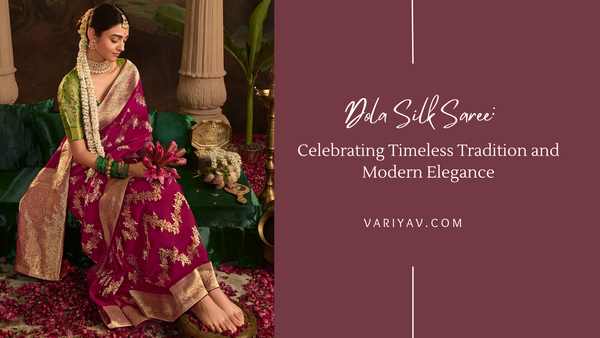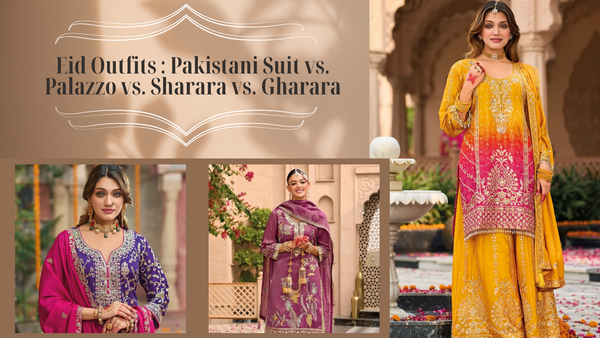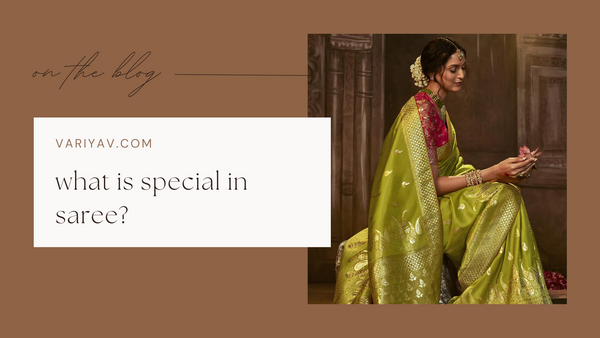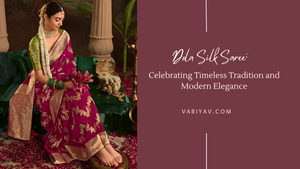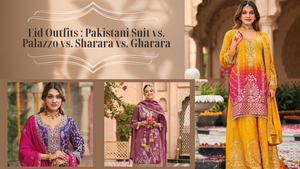what is special in saree?

A saree is more than a piece of cloth; it reflects the rich cultural heritage of India, possibly a canvas for intricate craftsmanship; it is one statement in the timeless expression of feminine elegance. Such beautiful pieces of garments have adorned women across the Indian subcontinent for centuries. Each has a story to say in its manner, its fabric, and design. But what is it about this piece of clothing that has allowed the saree not only to survive but to thrive over several thousand years? Let us take a deeper look at the many facets that make this piece of cloth so special: a peep into its history, versatility, craftsmanship, and its place in the modern world.
1. Culturally Established
Rooted in History It is over 5000 years old and probably one of the oldest surviving garments in the history of mankind. Even ancient Indian texts refer to it, such as the Rig Veda, along with historical texts evidencing that it has been one of the pivotal garments within Indian culture since time immemorial. Obviously, the word is derived from the Sanskrit word "sati," which refers to a strip of cloth. It evolved over many years into what today is worn-six to nine yards of fabric, the strip of cloth.
From the Jamdani muslin sarees of Bengal to the bright silk of Tamil Nadu's Kanjeevarams, each region has its way with the saree. Each of these textiles represents a host, not just another type of wearing apparel; it is rather a cultural artifact and a medium carrying the history, values, and tradition of the communities it represents.
2. An Art Form Expressed Through Fabric
Perhaps the most striking thing about this dress is just the work of art that goes into putting a saree together. Weaving a saree is not an exercise; rather, it is a form of craftsmanship which requires, among other things, skill and patience, but above all, imagination. Most of these sarees are interwoven by master craftsmen, with techniques passed from generation to generation. The curious thing about some of these weavers is that they often take many months to complete one single saree, especially in the case of costly material, like silk, or when elaborate designs are incorporated into it.
For instance, Banarasi Silk Sarees boast of their high and intricate zari works made of threads of gold and silver, which take weeks to accomplish. Because of such a royal look, these sarees are usually kept for occasions like weddings.
On the other hand, Patola Sarees of Gujarat involves double ikat weaving; first, the threads are tied and dyed before weaving. The result is such complicated geometrical patterns that both sides of the fabric remain identical. It is more a work of art that speaks to heritages than it does to aesthetics. Each sari holds within itself stories about it-through the motif stitched into its fabric or color used, or even through how differently it is worn in any particular region.
3. All-Season Garment Fit for Any Occasion
The saree, for many reasons, is one of those favorites that have managed to carry their appeal down generations. Most other garments are related to particular occasions, whereas the saree can fit into almost any events from casual to the most formal rejoicing. It includes light, airy, cotton sarees for daily wear. Among these are those crisp-and-nice Tant sarees of West Bengal, so very suitable for the tropical climate of India.
Celebratory Events: Festivals, for instance, Diwali require them to wear more designer sarees; Bandhej Rajasthan, famous for bright color palette and tie-and-dye motifs, or Paithani from Maharashtra, popularly known for its rich hues and broad zari borders.
Weddings: Sarees, therefore, form an intrinsic part of Indian weddings. From region to region, the bridal saree has its own tradition. For example, the nauvari saree of Maharashtrians is draped in a style akin to a dhoti and carries both practical and symbolic meanings. The South Indian Kanjeevaram saree with heavy silk and temple borders is another bridal favorite.
Corporate and Formal Wear: Saree has emerged as a strong statement in the corporate world for today's working woman. Sleek and subdued sarees in neutral tones or in subtle prints regularly adorn office wear across India, merging tradition with modernity.
4. A Symbol of Feminine Grace and Empowerment
A saree could bring out a woman's natural elegance and beauty in the most unique way. While most attire in the Western world aims to fit into a minimal definition of beauty, sarees are terribly inclusive on their own. The manner it drapes across the body celebrates curves and goes with every movement in a grand manner. It is not about concealing your body but adorning it with dignity and grace. Besides, the saree has emerged as an icon of empowerment. In a world that is getting increasingly West-centric in every fabric of fashion, the saree is conspicuous as one garment that puts women way ahead in the races. Wearing it can be an act of confidence-a celebration of heritage and a declaration of identity.
5. The Science of Saree Draping
A Unique Skill Passed Through Generations Wearing a saree is an art, skill, and practice in itself. More than a hundred ways of draping saree are described, each having its regional and community importance, besides not every community following the same pattern of draping within this one region.
Nivi Style: Most famous style of Andhra Pradesh, in which the saree is tucked around the waist and pallu is laid over the left shoulder; this is stylish and utilitarian; hence, it can be worn on any occasion.
Bengali Style: It is depicted with big pleats and pallu falling over the left shoulder loosely. Used to consider as one of the grace- and femininity-enhancing saree-wearing styles.
Maharashtrian Nauvari: In the Nauvari saree, the dhoti style of draping allows more freedom of movements and, hence, is more comfortable. Traditionally, Maharashtrian women wear this on festive and ceremonial occasions.
Gujarati Style: In this style, the pallu falls over the right shoulder covering the front portion of the body. It finds its application at weddings and also when celebrating a festivity.
Go through what are the different styles of draping sarees? to know more about saree draping, Saree-wearing is a traditional art passed on to the little girls by their mothers, grandmothers, or aunts while learning from the older one. It is an art passed down the generations, much like wisdom and ethics of the previous yesteryears.
6. Saree in Global Fashion Scene
A Cultural Ambassador Over the last couple of years or so, saree has crossed all its conventional barriers and made a strong impression in the world of Global Fashion. At present, international designers embedded a host of saree elements into modern fashion. Celebrities across the globe have been spotted on red carpets wearing sarees, confirming its position in global fashion.
Designers like Sabyasachi Mukherjee and Manish Malhotra have garnered enough repute for themselves even in terms of bringing the saree into international attention. The work has been boarded onto celebrities like Priyanka Chopra, Deepika Padukone, and even global icons like Naomi Campbell. It is from this base that such loaded statements hold the saree to be an internationally appealing piece of regalia because of its tradition-modern quality that drips from every thread of its wear.
The saree has also become a part of cultural diplomacy each time some female Indian diplomat or leadership represents India on some international platform. It reminds people of the rich cultural heritage of India and the impacts the country has made on global fashion trends.
7. Sustainability and Ethical Fashion
Timeless Appeal of Saree While the concept of sustainability and ethics in fashion really catches on, the saree bears all the hallmarks of a model in slow fashion. Most sarees are made from natural fibers like cotton, silk, and wool, which are chiefly biodegradable and eco-friendly materials. Besides, a big percentage of saree production comes through the handloom industry, which, in that way, sustains the livelihoods of millions of weavers and artisans besides keeping traditional craftsmanship alive.
Another aspect adding on to its sustainability is: how durable it is. A good one, when made, could last for decades and often turns out to become a family heirloom, passing down generations after generations. Unlike garments of fast fashion, designed to survive just a few wear-and-tear instances before being chucked into the rubbish bin, a saree is something to be kept and cherished.
They are saving the fabric handloom sector, so important for the livelihood of the local artisans and adding such importance to the rich fabric of Indian culture. The saree symbolizes responsible fashion-a niche market segment that insists on craftsmanship, sustainability, and preservation of heritage.
8. The Saree: From an Emotional Connect to Generation
Of course, to many women, there is indeed much more to a saree than just a piece of cloth; it's a storage of memory. More often than not, a saree has quite a few emotional values ingrained in it, either from the saree she wore on her wedding-day, the one treasured from her grandmother, or the one she wore to her first job interview. These are the weaves in the fabric of their lives that are marked with milestones and remembered through life.
A saree is not just an emotional attachment but also depicts many untold stories-of the weaver, his history, the tradition he brings to the commoner, or even one that the wearer holds dear. This may be one of the reasons why even in these times of fast-changing fashion, women stuck to and wore sarees.
Conclusion:
The Saree—Eternal Appeal As a matter of fact, the saree is infinitely more than just a piece of apparel; it's a continuing tradition, an exquisite piece of art, a graceful icon, and a cultural ambassador, all rolled into one. Among timeless appeals, versatility in the garment itself, rootedness in history, and adaptability through the ages to the spirit of the times without loss of its spirit-all have given birth to innumerable interpretations. Explore variyav.com to see the stupendous range of sarees that you could wear and represent Indian culture styles. Come, learn to know yourself better, exactly what kind of sarees do you need to buy: casuals or the dressy look.



